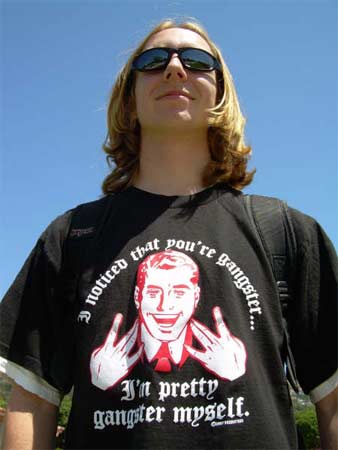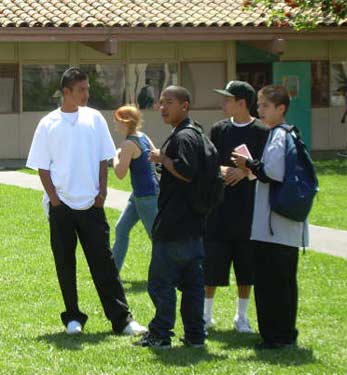A Student in Gangster’s Clothing
Proposed Clothing Ban Targets Supposed Gang Attire

When I entered high school, I quickly learned that the dress code seems to follow the saying, “anything goes.” However, the Santa Barbara School District intends to change that attitude with proposed bans that, surprisingly, will affect young men. Its recent dress code proposal is focused on banning distracting clothing, namely “gang-related apparel.” The policy is proposed by the school district’s compliance director, Michael Gonzalez, and may go into effect as soon as the end of the month.
Under the current dress code, the school district may restrict specific “gang-related apparel” when “the school has identified the necessity for the restriction(s) and the school provides a reasonable description of the restricted apparel.” As a result, the proposal bans specific “gang-related apparel” including: long shorts worn with socks above mid-calf; plain white t-shirts worn with a black or blue t-shirt; sagging pants worn below the waist; gang writing, colors or emblems; belt buckles with initials; handkerchiefs or bandanas; and black gloves. Some of these regulations are already enforced at Santa Barbara High, including the ban on black gloves and gang gestures and memorabilia. However, the new attention on long socks, plain t-shirts and baggy pants is causing many students grief.

Santa Barbara High students Aaron Nevarez and Leo Rodriguez are among a group of students who would be breaking the new policy. Neither had heard of the dress code proposal before, but were skeptical upon reading the proposed bans. Nevarez argued that the policy is unfair because these articles of clothing are very common, so that if the proposal was passed, very few people would follow it. He continued that students might go so far as to transfer schools to keep their choice of clothing. Meanwhile, Rodriguez was nearly speechless. He motioned to his white t-shirt and baggy khaki pants and exclaimed, “These are the only clothes I’ve got!”
On the other hand, student Ryan Cook first thought that banning gang-related attire was a good idea that could possibly reduce the amount of gang activity on campus. Cook said he supported the prevention of gang affiliations, including a ban on “eastside” or similar such slogans. However, upon reading the full list of unacceptable attire, he began to question that the proposal would not have its intended effects. Also, after pointing out that his friend Hunter Myers could be cited for his combination of white and black t-shirts, Cook started to think that the proposal was ridiculous. He said that it would be “unfair to make [economically] unfortunate kids buy new clothes.” He thought that it would be better to ban specific gang-related words or symbols, not certain articles of clothing.
The large t-shirt, baggy pants, and long white socks is seen in variations around campus from many students who do not identify as gang members. “It’s a style of clothing,” student Jorge Santana stated. “It’s not gang-related.” Students Adrian Diosdado and Geoffrey Parker agreed, saying that students who actually are gang members do not always dress this way. In fact, so many students follow this type of dress that the proposal may lose its intentions. It attempts to curb dress that will “cause actual distraction from or disturbance in any school activity.” Parker responded in defense, “Gang-related clothing is normal and less distracting than suits, button-down shirts and other business attire at school.” Gang-related attire is so common that to some, it does not constitute as a distraction.

The proposal seems to be based on the logic that these articles of clothing are associated with gang membership, regardless of whether the students wearing them participate in gangs. Diosdado follows this idea, believing that if students dress like this, they need to be aware of the image they are projecting. However, he noted that this proposal would justify the targeting of certain students and promotion of the connection between gang membership and these clothes. Since this association already exists, this would continue the current fear in the community and on campus of students who dress this way. Diosdado thinks this proposal would target the Latino community and continue the stereotypical image of a gang member. Not to mention, the proposal would increase student animosity towards school officials.
The dress code proposal also includes banning house slippers or bare feet; clothing with excessive holes or tears; and details on “inappropriate female clothing.” The school board will discuss this policy at their next meeting on Tuesday, April 22 at 6 p.m..



